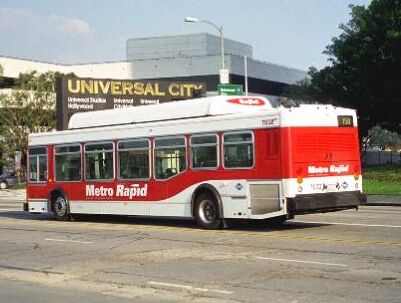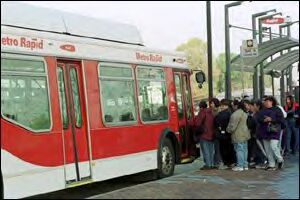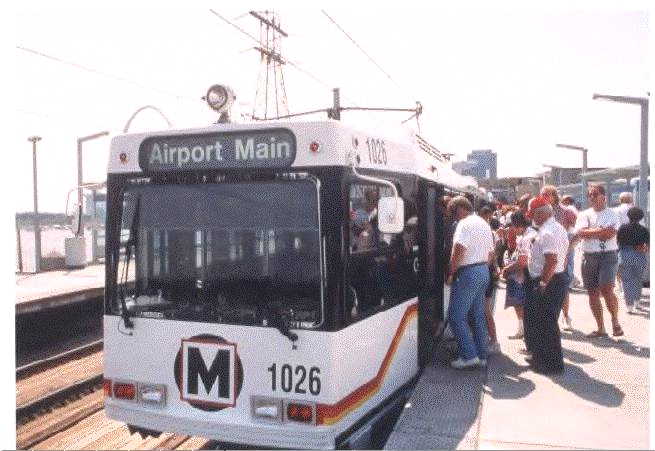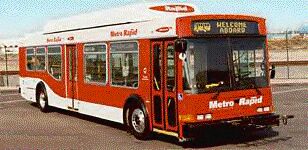 The so-called Metro Rapid "Bus Rapid
Transit" (BRT) services instituted by the Los Angeles Country Metropolitan
Transportation Authority (LACMTA) have been widely publicized as a veritable
"poster child" for BRT. These routes, on LA's Wilshire-Whittier and Ventura
Boulevards, were launched, at relatively low capital cost, in summer 2000 in conjunction with the San Fernando Valley
extension of the Red Line rail subway, to which they also serve as "feeders". They consist of brand-new, CNG-fuel buses operating
with prioritized traffic signals in mixed traffic. Stop spacing for the new routes was significantly widened to approximately every 0.8
to 1.0 mile (while new, high-tech stations with passenger amenities were installed). Most of these improvements increased bus
schedule speeds; in the case of the Wilshire-Whittier route (720), for example, to 15 mph.
The so-called Metro Rapid "Bus Rapid
Transit" (BRT) services instituted by the Los Angeles Country Metropolitan
Transportation Authority (LACMTA) have been widely publicized as a veritable
"poster child" for BRT. These routes, on LA's Wilshire-Whittier and Ventura
Boulevards, were launched, at relatively low capital cost, in summer 2000 in conjunction with the San Fernando Valley
extension of the Red Line rail subway, to which they also serve as "feeders". They consist of brand-new, CNG-fuel buses operating
with prioritized traffic signals in mixed traffic. Stop spacing for the new routes was significantly widened to approximately every 0.8
to 1.0 mile (while new, high-tech stations with passenger amenities were installed). Most of these improvements increased bus
schedule speeds; in the case of the Wilshire-Whittier route (720), for example, to 15 mph.
[Source: FTA BRT website 2001/03/01; ExpoRail 2001/10/09]
Certainly, these new routes represent an important service
improvement for many passengers, and clearly total transit ridership in the corridor has increased. But is Metro Rapid BRT
service really an effective substitute for rail transit, as many BRT proponents claim? How does its track record in luring riders from
the automobile compare with that of rail transit, including light rail (LRT)?
Recent data from the December 16, 2002 issue of Passenger Transport provide some indications, in a report on LACMTA's
Ventura and Wilshire-Whittier Metro Rapid BRT routes (#750 and #720). According to this report, before the 300 route-series
limited-stop buses were upgraded to 700-series Rapid Buses,
they and the parallel local routes carried approximately 38,800
weekday passengers. That has now increased almost forty
percent to 54,000, with 9,000 on Ventura and 45,000 on Wilshire.
 However, only 13 percent of the increase
(one third of forty percent) was totally "new" transit business – presumably, most
of these riders from automobiles. With free transfers valid only for Rapid Buses, the
new Metro Rapid service apparently took many of its passengers off the Red Line
subway and other grid system buses (all of which applied an extra 25-cent transfer charge).
However, only 13 percent of the increase
(one third of forty percent) was totally "new" transit business – presumably, most
of these riders from automobiles. With free transfers valid only for Rapid Buses, the
new Metro Rapid service apparently took many of its passengers off the Red Line
subway and other grid system buses (all of which applied an extra 25-cent transfer charge).
 The 13 percent new Metro Rapid BRT
ridership increase does not compare well with new ridership levels attracted to LRT.
For example, 91 percent on the Saint Louis Metrolink LRT (see photo at right) were
totally new riders, and 40 percent on Baltimore's LRT; and the USA average for
totally new ridership on LRT is 50 percent, as reported in TRB paper #980318 by John Neff of APTA.
The 13 percent new Metro Rapid BRT
ridership increase does not compare well with new ridership levels attracted to LRT.
For example, 91 percent on the Saint Louis Metrolink LRT (see photo at right) were
totally new riders, and 40 percent on Baltimore's LRT; and the USA average for
totally new ridership on LRT is 50 percent, as reported in TRB paper #980318 by John Neff of APTA.
While LACMTA's Metro Rapid BRT service is definitely a laudable
and supportable upgrade of transit service, it would appear that
the operation is not nearly the unqualified success that BRT
proponents, including the Federal Transit Administration, FTA
claim. The rail systems in Los Angeles have attracted far more
new ridership; and with LRT transporting riders at a 44 percent
lower operating cost per passenger-mile than bus, it would appear
that rail transit offers much greater cost-effectiveness in the longer term.
[Source: FTA NTDB 2000]
